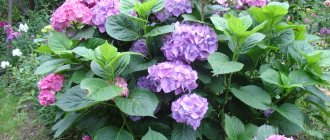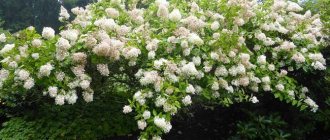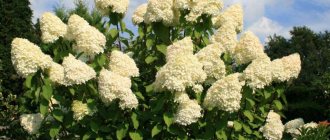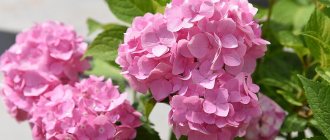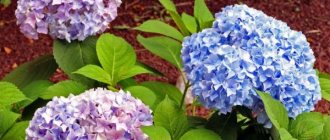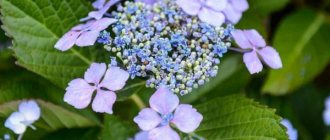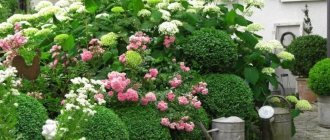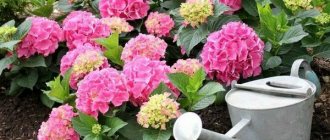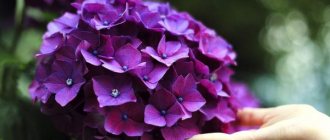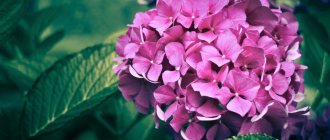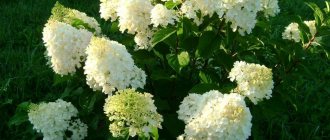The height, taking into account the blossoming inflorescences, does not exceed 70 cm. During the period of abundant flowering, Bobo is a cluster of flowers, behind which the leaves are almost invisible. The variety was developed in 2011 and in just a decade managed to gain recognition among landscape designers around the world.
Description of the variety
Hydrangea paniculata Bobo or paniculata hydrangea Bobo is a dwarf shrub that grows no more than 70 cm in height. However, its diameter is only half a meter. The shoots and fairly small leaves of Bobo, in contrast to the large-leaf varieties, are dark green, so against their background the large panicle inflorescences look very impressive.
Did you know? Hortense is named after the princess of the Roman Empire, who had the name Hortense.
These inflorescences consist of many small flowers, somewhat reminiscent of phlox. The color of the flowers depends on the mineral content of the soil. Their natural color is snow-white, but if iron or aluminum compounds are added to the soil, the flowers acquire yellowish, soft lemon or light pink shades. This variety begins to bloom in June, but only in small single inflorescences.
And from July to September the bush is covered with a delicate blooming cloud. Hydrangea paniculata Bobo is also so popular due to its excellent resistance not only to winter frosts, but also to frosts that often occur in spring. And it is also absolutely unpretentious in the choice of soil, so it is not difficult to grow it in any garden plot.
History of selection
Bobo paniculata hydrangea, which appeared in Europe in the 18th century, has earned the recognition of gardeners. The delicate bushes, brought from Japan, are prized for the opportunity to admire the magnificent balls of inflorescences. Breeders from different countries helped the unique shrub fill the gardens of Europe.
The hydrangea variety Bobo (Hydrangea paniculata Bobo) was bred by scientists from Belgium, receiving an award at the Florall flower exhibition for the best new frost-resistant variety. As a result of many years of breeding work, this species now has winter hardiness and a variety of colors.
Riot of flowering
In landscape design
Due to its excellent external characteristics, Bobo paniculata hydrangea is widely used in landscape design. It looks very impressive in group plantings along borders; it is used to zone the territory of a garden and park. It can decorate both garden plots and urban recreation areas for children and adults. It is planted for landscaping loggias and gazebos.
The panicle inflorescences look very beautiful together with the spherical ones, but they need to be planted in a certain order, which will favorably emphasize the beauty of each bush. You can also plant multi-colored paniculate hydrangeas together or combine Bobo with pink and lilac phloxes.
Common diseases and pests
Possessing high immunity to infections, Bobo rarely gets sick. Problems usually arise due to improper care. Thus, if there is a lack of iron in the soil, the cultivar may develop chlorosis. The application of iron-containing preparations at the root will help defeat the disease.
The hybrid is also sometimes affected by downy mildew. The appearance of yellow spots on the green part of the plant indicates an overly moist environment. At the first signs of disease, the bush is sprayed with a fungicide solution, for example, “Fundazol”.
Often aphids or spider mites settle on hydrangeas. You can get rid of them using insecticides (for example, “Aktara” or “Aktellik”). But it is better to collect snails or slugs mechanically (by hand).
Landing
If you want to plant this unusually beautiful variety of hydrangea at home or in your garden, you need to know the basic rules for planting it. Often it is carried out with seedlings purchased in specialized stores or nurseries. But you can also grow a full-fledged shrub from seeds. This method is otherwise called generative; it is used, as a rule, to conduct breeding experiments.
Seeds
Very often, Bobo hydrangea is grown using seeds. It is advisable to buy them in trusted stores in order to get high-quality seedlings. Sowing is carried out only in autumn, and the air temperature in the germination room should be at +14...+20°C. If the thermometer is higher or lower than this level, the process may be disrupted.
Gardening tips
- Experienced gardeners note that the color of hydrangea depends on the presence of aluminum sulfate in the soil. There are drugs on sale that help it change color.
- In autumn, it is better to replant plants with a strong root system. This will allow the hydrangea to take root and become stronger before frost begins. Weak plants take longer to accept and may not survive the cold winter.
- As soon as the hydrangea inflorescences weaken and decrease in size, it needs a rejuvenating haircut. The bush is pruned “under the stump”, that is, stems 15-20 cm long from the ground are left. The plant tolerates such manipulation well. It grows very quickly and blooms luxuriantly again.
It’s not for nothing that hydrangea is called the queen of the garden. This beauty went to this title thanks to its lush and long-lasting flowering. The Bobo variety is winter-hardy and practically not susceptible to disease. Today this plant is winning the hearts of gardeners with its beauty and unpretentiousness.
During flowering, the bush looks like white lace; due to the large number of inflorescences, the leaves are almost invisible. Those who decided to have a Bobo hydrangea in their garden, a description and photo of which we presented in this review, will be pleased with its abundant and long-lasting flowering.
Care
Hydrangea Bobo is so loved by gardeners precisely because of its ease of care. In order for this plant to grow well and bloom long and abundantly, it is necessary to feed it in time, water it, loosen the soil, form a crown and prepare the bushes for wintering.
Watering and fertilizing
Watering should be carried out at least twice a week in the summer so that the soil does not dry out, as this can lead to the plant dying. In cloudy weather and during rains, you can water once instead of twice. The water should be settled or rainwater, since the lime contained in tap water is very harmful to hydrangea.
Important! It is recommended to add a few grains of potassium permanganate to the water for watering paniculata hydrangea.
Feeding this variety is necessary to ensure better growth and flowering. The main thing is to fertilize on time and in the required quantities. In spring, summer and autumn, the volume and quality of fertilizing may vary. It is necessary to ensure maximum nutrition of the plant with useful substances.
Feeding Bobo hydrangea is carried out according to the following scheme:
- Immediately after the snow melts, it is necessary to add organic fertilizers to the soil under the bushes so that leaves form better. In this case, mullein solution is perfect.
- During the formation of buds, the plant is watered with a solution of phosphorus and potassium fertilizers, to which urea is added.
- In summer, when the most active phase of flowering is underway, a complex of minerals designed specifically for flowering plants is added. You can buy it in the store ready-made and add it according to the instructions on the package.
- In mid-autumn, it is once again necessary to apply complex mineral fertilizers, which should not contain nitrogen-containing substances. This feeding is carried out to more effectively prepare the plant for winter.
Mulching
The soil under the Bobo hydrangea is mulched to retain moisture, because this is vital for the plant. In addition, this way the soil remains looser and allows air to pass through well, which is very important for feeding the roots. Before mulching, shallow loosening is required , sparing the roots, which are very close to the surface. Tree bark or pine needles are usually used as mulch. You can also sprinkle the ground under the bushes with peat, which will help maintain an optimal acidity level.
Did you know? In North America, archaeologists have found evidence of the existence of hydrangea 40 thousand years ago.
Trimming
Bobo hydrangea bushes are pruned in spring and autumn. It is divided into three types: rejuvenating, sanitary and formative. In early spring, after the snow melts, it is necessary to remove all frozen and damaged shoots. In this case, it is advisable to shorten annuals, leaving no more than 5 buds on each.
In the fall, in preparation for winter, all low-quality branches are cut off again so that they do not interfere with the development of the plant. It would also be a good idea to slightly rejuvenate it by removing all overgrown shoots, as well as those that thicken the bushes.
To decorate the landscape, you need plants with a beautiful, properly trimmed crown, so it can be shaped according to your preferences. The Bobo variety lends itself very well to formative pruning. It is not advisable to skip it, because this can lead to severe thickening, stretching of shoots in height, and also a decrease in the quality of flowering.
Winter hardiness and shelter for the winter
To properly prepare Bobo paniculata hydrangea for winter, you must perform the following steps:
- Reduce the number of waterings starting in September.
- When cold weather sets in, trim off the top leaves.
- When the first frosts begin, trim off the remaining leaves, leaving only the top ones near the new buds.
- Mulch the bushes with peat or leaves. The mulch layer should be at least 10 cm.
In regions with fairly cold winters, it is advisable to press the bushes to the ground and cover them with spruce branches, and if the winter is relatively warm and snowy, you can even do without hilling, because Bobo hydrangea has good winter hardiness and resistance to slight spring frosts.
Features of agricultural technology
The Bobo variety is quite undemanding in terms of growing conditions. But good growth and regular flowering can only be achieved by following simple rules for choosing a place to plant Bobo paniculata hydrangea. Important for the plant is:
- Illumination;
- Humidity;
- Soil composition.
The plant develops best in partial shade. It will also grow in a sunny place, but its leaves and inflorescences may suffer from sunburn. Therefore, hydrangea is planted in places protected from sunlight.
Like any other panicle hydrangea variety, “Bobo” loves moisture. Drying out the soil usually leads to the death of the plant. But stagnation of water in the soil is also undesirable. It is better to plant the plant in humid places without stagnant water.
This variety is grown on acidic, slightly acidic and neutral soils. Alkaline soils are not suitable for Bobo hydrangea, as it quickly dies on them.
This dwarf variety can be used in the design of garden plots and parks. It is universal, it is used in single and group plantings, in alley plantings, for borders and terraces. Due to their small size, these compact bushes look very beautiful even in small flower beds. They are often planted in garden vases and containers, which are brought indoors for the winter.
Conditions of detention
Hydrangea cannot be considered one of the most unpretentious plants. But you can provide her with ideal living conditions and optimal care without much difficulty. Even a novice gardener can grow Bobo hydrangea.
Lighting and location
Hydrangea Bobo does not like direct sunlight. The optimal place for planting it in open ground is a shaded area, partial shade. If you plant a shrub on the sunny side, it will grow and develop poorly. And the inflorescences will lose volume and color.
Temperature
This hydrangea variety was bred specifically for European countries. Therefore, Bobo feels good in the Russian summer if the right place is chosen for her: it does not get hot in partial shade. The plant also tolerates winter frosts well. In central Russia and southern Russia, shrubs overwinter without shelter, with the exception of young seedlings, which may die without it. Insulation for the winter is also required for hydrangeas grown in the northern regions of the country.
Air and humidity
Hydrangea loves moist air, but does not tolerate stagnation. Therefore, the place where it grows must be well ventilated. Otherwise, the bush will get sick. But the plant does not tolerate drafts and sharp cold winds. Therefore, you should not plant hydrangea in open areas.
Priming
The shrub prefers to grow on fertile and loose soils with a slightly acidic reaction. Then the flowering will be long, and the inflorescences will be voluminous and bright.
Reproduction
If you want to propagate Bobo hydrangea, you can use three methods: cuttings, dividing the bush and layering. Each of these methods is used at a certain time, and each of them has its own advantages and disadvantages.
Cuttings
Using green cuttings, you can propagate this variety very effectively. They are usually cut in early spring, before buds form.
Important! Insect pests that settle on hydrangeas can be carriers of viral diseases that cannot be treated and lead to the death of the plant.
This process is carried out in the following sequence:
- Choose healthy, strong shoots with at least 5 buds.
- Cut cuttings from them and soak them in a solution of a root formation stimulator.
- Stick them into open ground in a shaded place protected from drafts to the depth of two buds.
- Keep the soil moist to help the cuttings root as quickly as possible.
After rooting, each of them will need to be transferred to a separate container and grown for about two years, and then planted in a permanent place. This method is quite lengthy, and besides, not all cuttings can subsequently become full-fledged plants.
By layering
It is best to propagate by layering in May.
Learn how to replant hydrangeas to another location.
To be most effective, you need to do the following:
- Bend a good young shoot to the ground.
- Make a cut in the part that touches the soil.
- Sprinkle with peat and constantly maintain the required level of humidity.
- After the roots have formed at the site of the cut, carefully separate the cuttings from the large bush and transplant them into a separate container, where they will grow and wait for planting in a permanent place.
Dividing the bush
This method, like cuttings, is also practiced in early spring, when flower buds have not yet appeared.
We advise you to find out why paniculate hydrangea does not bloom.
For this purpose the following events are carried out:
- Dig up a large bush.
- Divide it into several parts so that each of them has buds.
- Shorten the roots a little.
- Dig holes twice as large as the size of the root system of young bushes.
- Fill it halfway with fertile soil consisting of peat, compost and mineral fertilizers.
- Carefully place the bushes in the holes and sprinkle with the rest of the soil mixture.
- Tamp down a little and water the new plant well so that it takes root and begins to grow as quickly as possible.
This method compares favorably with others due to the fact that it is the simplest and fastest. But it can only be used if the bush is too large and can be divided.
What we found out
Among the advantages of BoBo hydrangea are:
- Miniature appearance;
- Possibility of cultivation as a house flower;
- Color options;
- Plant resistance to temperature changes, diseases or pests.
Among the shortcomings, only the need for constant attention to the soil is worthy of mention, otherwise the plant may die due to lack of moisture or oxygen. In general, BoBo hydrangea is an unpretentious plant, easy to grow and care for, which even a novice gardener can handle. The main thing is to give the plant your love and care.
Currently reading:
- How to grow Chinese cabbage in open ground
- Increased potato yield using Dutch technology
- Varieties, planting and care of perennial rudbeckia
- Planting to decorate the site with three types of coniferous trees
Share the news on social networks
About the author: Lyudmila Vasilievna Nosikova
Agronomist of the state agricultural enterprise "Garovskoe" of the Khabarovsk region of the Khabarovsk Territory.
